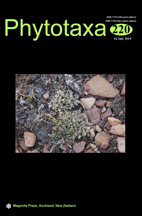Abstract
A distinctive morphotype consisting of an epilithic, one-layered colony of polarized, 1–3-celled pseudofilaments was recognized in the rocky shores of the state of Oaxaca in the Mexican tropical Pacific. Morphologically, it was not identifiable as any species of a previously described genus. It is similar to species from the former order Chroococcales, recently modified by Komárek et al. (2014), in its sessile heteropolar pseudofilaments. Specifically, it is most similar to the colonial species of the genus Chamaesiphon; and of Chamaecalyx, but the cells of the Mexican populations divide symmetrically in one or two planes, differentiating them from Chamaesiphon which divides asymmetrically and only in one plane, and from Chamaecalyx, which has multiple fission. The other defining feature is that all cells of the pseudofilament have differentiated mucilaginous structures (pad and/or stipe and cup). It has not been possible to obtain cultures of our material for further studies to complete the polyphasic approach. Nevertheless, its morphological characteristics and life cycle, plus its distinctive extreme biotope, form a unique combination of features that derive in our proposal of the morphogenus Nisada gen. nov., with the type species, Nisada stipitata, sp. nov. We describe the proposed taxa and the problems and current inconveniences regarding its assignment to higher taxonomic levels. We also discuss the different degrees of complexity of heteropolarity in Nisada and other taxa.

